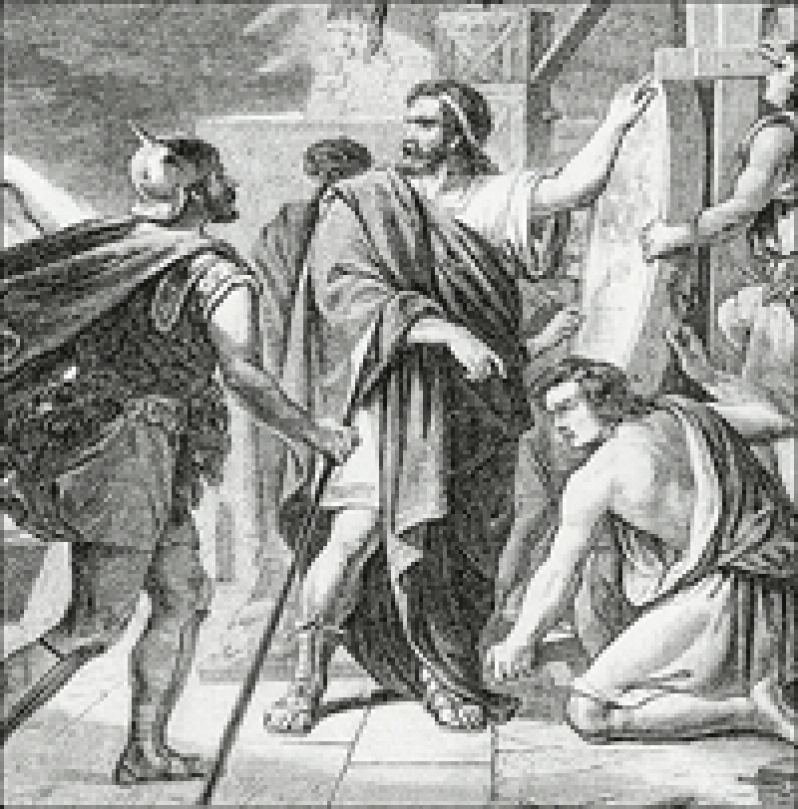The genius of Archimedes
ARCHIMEDES is one of the greatest mathematicians ever — and certainly the most famous of ancient Greece.  Many of his discoveries were centuries ahead of their time. The Archimedean Screw, a device for raising water from a low to high level, is still used more than 2,000 years later in waste treatment plants.
Many of his discoveries were centuries ahead of their time. The Archimedean Screw, a device for raising water from a low to high level, is still used more than 2,000 years later in waste treatment plants.
Archimedes was born in Syracuse, in modern-day Sicily, in 287 BC and educated in Alexandria, Egypt.
He spent most of his life in Sicily, dedicated to research and experiment. He is best known for his work calculating the areas and volumes of curved objects and figures, as well as for being the first person to study hydrostatics (the behaviour of fluids and objects immersed in them).
The latter led to the famous (but probably apocryphal) incident involving Archimedes’ bath. It is said that as he stepped into it, Archimedes realised that the amount of water he displaced exactly equalled the volume of that part of his body which was submerged.
It is said that he leapt from the bath and ran down the street naked, shouting “Eureka!” meaning, “I’ve found it!”
The importance of the discovery was in giving rise to Archimedes’ Principle — which states that any object which is completely or partly submerged in a fluid (water, for the sake of argument) is pushed upwards by a force equal to the weight of the fluid it displaces.
Looked at another way, this means that the object loses as much weight as the weight of the water it displaces.
A ship lowered into the sea will sink down until the weight of water it displaces equals its own weight. Objects that are denser than water, therefore, weighing more than the amount of water they displace, sink. Less dense objects float.
Archimedes is once said to have used his Principle to expose a fraud against King Hiero II of Syracuse, who suspected that a new solid gold crown he had ordered was partly made of silver.
He took equal weights of gold and silver and weighed them in water. In water, of course, they would weigh different amounts because they are of different densities. Then he weighed the King’s new “gold” crown and a replica made from silver, both in water. He was able to compare the results, and calculate that the crown was indeed not solid gold.
Perhaps Archimedes’ greatest claim to fame, however, is his work with areas and volumes. When he wrote ‘On the Sphere and Cylinder’, he was the first person to calculate that the volume of a sphere is two-thirds that of a cylinder into which it will fit exactly. He also calculated that the surface area of a sphere is four times that of its largest circle.
In ‘Measurement of the Circle’, he worked out pi, the figure by which a circle’s diameter is multiplied to calculate its circumference, to be about 3.14 (it’s 3.14159265 to eight decimal places).
Archimedes’ other great works include ‘Floating Bodies (about hydrostatics)’, ‘The Sand Reckoner’ and ‘Spirals’.
He is said by his contemporaries to have been a great astronomer, though little evidence survives of his findings. His inventions are of particular note, and several of his war machines were used to defend Syracuse from the invading Romans in 213BC.
The most spectacular, though this is possibly legend rather than fact, was a system of mirrors which the city’s defenders used to torch the Roman fleet. It is said to have deflected the sun’s rays on to the Romans’ ships, which were covered with highly-inflammable tar for waterproofing.
Archimedes was killed when the Romans finally took the city in 212BC. Legend has it that when a Roman soldier found him drawing a maths problem in the sand, Archimedes retorted: “Do not disturb my diagrams,” and was promptly killed. (TheSun.co.uk)
Once upon a time in history…
SHARE THIS ARTICLE :
Facebook
Twitter
WhatsApp



.jpg)








